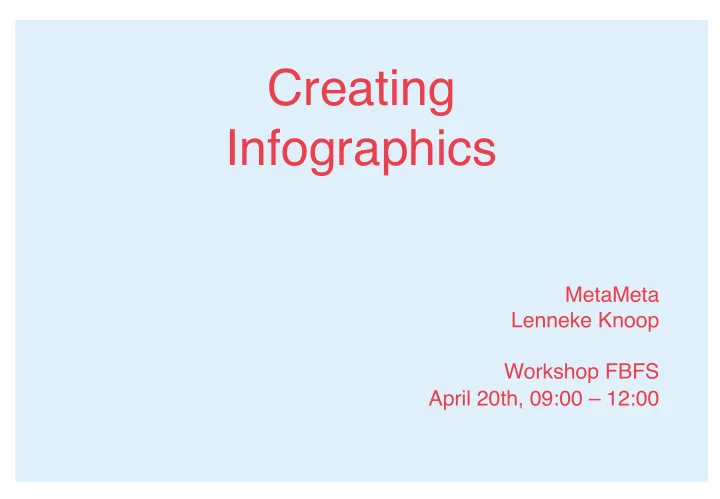

Creating Infographics MetaMeta Lenneke Knoop Workshop FBFS April 20th, 09:00 – 12:00
Today’s program 1. Introduction 2. Infographics: Data visualization 3. Infographics: The process 4. Infographics: Storytelling 5. Creating infographics 6. Group work 7. Reflections
Researchers and infographics - Everybody likes simple language.. More often asked in journals.. Is there a trend? - Examples of famous researchers sharing stories, rather than scientific articles - Visual abstracts
2. Infographics: Data visualization
Data visualisation vs infographic Data visualization Infographics
Data visualisation is… - Quantifiable information in the form of numbers - Data visualisation is objective, - created for the purpose of making sense of the data, - or to make data more accessible. - Likely to be created automatically - Transferable process to other data sets - Graphic design is often less important
Infographics… - Contain information presented within context - Are designed to tell or explain a specific story - Are intended for a specific audience - Are subjective - Are content enriched by illustrations, icons and other graphical flairs - matching your audience and purpose (journal / website / poster)
- Add another good example
Why do infographics work? ?
The power of images?
visual by neomam.com
visual by neomam.com
Informavores We’re all informavores now, hunting down and consuming data as our ancestors once sought wooly mammoths and witchetty grubs.’’ - Rachel Chalmers
We consume information equivalent to 174 newspapers per day. (up to only 40 newspapers in 1984) 9 Alleyne, R. (11 Feb 2011). Welcome to the information age – 174 newspapers a day. The Telegraph.
Information overload visual by neomam.com
visual by neomam.com
visual by neomam.com
3. Infographics: The process
Part 1: What to ask? - What is the purpose? - Which data am I going to use? - Why will people share it (who are they?) - How can I maximise that?
Data: make choices - Challenge: find a balance
Find your hook - What is the take away for the header? - Use this as hook / focal point - Build your story around it
Tell your story introduction / foundation Ah-Ha! The Main Event Classic example of clear conclusion / call-to-action storyline: http://infographicjournal.com/w p- content/uploads/2016/04/Adem ero_Impacts-of-a-Paper-Based- System_infographic1.png
Creating Infographics 1. Choose a format 2. Build a wireframe 3. Visualise as much as possible 4. Strengthen your hook visually 5. Reflect and revise Be creative
Choose a format
1. Choose a format: most used Often used starting points visual by easel.ly
Build a wireframe - Lay out your concept - Make a sketch of the hierarchy - Use this step to have your concept reviewed
Visualise: basic principles Scale - proportion Unity – harmony Dominance - emphasis Balance Similarity - contrast Hierarchy
Use colours - Limit your colour palette - Stick to 3 to 6 colours - Available tools e.g. www.colourlovers.com
Fonts Fonts are great to spice up your infographic - Think about (contrast in) style, size, weight - Appropriateness - Avoid small differences - Functionality / interpretation
- Add good / bad examples
4. Strengthen the hook visually Visualize the hook Smashing magazine: Do’s and don’ts of Amy Balliet
Images - Wikimedia - Freepik - Shutterstock - Vector images vs non vector
Style - When you make a series style is important - Create your own
Reflect and revise
Test and revise - Discuss your infographic with others, does it convey the right message, is the infographic clear? - Make a test-print - Think about how do you want to publish - Think about file size - See if everything is in place - Clean up the design from small errors - Make sure you include proper credits
Online tools - There are many - THE best tool does not exist - Tools come and go - An (elaborated!) overview can be found here: http://www.coolinfographics.com/tools/
Work with easel.ly - http://www.easel.ly/ - Sign up, create a free account - Help centre: http://help.easel.ly/help_center - Choose formats or start from scratch - If you have data you can insert directly from excel (note: if exceldata is the majority of your infographic, choose Piktochart)
Our inspiration & references - Americanscientist - Newsilike.in - Piktochart (online tool similar to easel.ly) - Data visualization tools and resources - http://www.landscapes.org/glf-2014/data-landscapes-infographic-data- visualization-competition/data-visualization-tools-resources/ - Gap minder - http://www.gapminder.org/downloads/ - Amazing maps on facebook (rethink conventional maps) - https://www.facebook.com/MapsAreAmazing/ - 90 best infographics - http://www.creativebloq.com/graphic-design-tips/information-graphics- 1232836 - https://www.in60seconds.nl/blog/
Recommend
More recommend